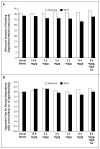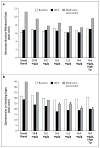Randomized Trial of Reduced-Nicotine Standards for Cigarettes
- PMID: 26422724
- PMCID: PMC4642683
- DOI: 10.1056/NEJMsa1502403
Randomized Trial of Reduced-Nicotine Standards for Cigarettes
Abstract
Background: The Food and Drug Administration can set standards that reduce the nicotine content of cigarettes.
Methods: We conducted a double-blind, parallel, randomized clinical trial between June 2013 and July 2014 at 10 sites. Eligibility criteria included an age of 18 years or older, smoking of five or more cigarettes per day, and no current interest in quitting smoking. Participants were randomly assigned to smoke for 6 weeks either their usual brand of cigarettes or one of six types of investigational cigarettes, provided free. The investigational cigarettes had nicotine content ranging from 15.8 mg per gram of tobacco (typical of commercial brands) to 0.4 mg per gram. The primary outcome was the number of cigarettes smoked per day during week 6.
Results: A total of 840 participants underwent randomization, and 780 completed the 6-week study. During week 6, the average number of cigarettes smoked per day was lower for participants randomly assigned to cigarettes containing 2.4, 1.3, or 0.4 mg of nicotine per gram of tobacco (16.5, 16.3, and 14.9 cigarettes, respectively) than for participants randomly assigned to their usual brand or to cigarettes containing 15.8 mg per gram (22.2 and 21.3 cigarettes, respectively; P<0.001). Participants assigned to cigarettes with 5.2 mg per gram smoked an average of 20.8 cigarettes per day, which did not differ significantly from the average number among those who smoked control cigarettes. Cigarettes with lower nicotine content, as compared with control cigarettes, reduced exposure to and dependence on nicotine, as well as craving during abstinence from smoking, without significantly increasing the expired carbon monoxide level or total puff volume, suggesting minimal compensation. Adverse events were generally mild and similar among groups.
Conclusions: In this 6-week study, reduced-nicotine cigarettes versus standard-nicotine cigarettes reduced nicotine exposure and dependence and the number of cigarettes smoked. (Funded by the National Institute on Drug Abuse and the Food and Drug Administration Center for Tobacco Products; ClinicalTrials.gov number, NCT01681875.).
Figures




Comment in
-
Reduced-Nicotine Cigarettes--A Promising Regulatory Pathway.N Engl J Med. 2015 Oct;373(14):1289-91. doi: 10.1056/NEJMp1509510. N Engl J Med. 2015. PMID: 26422720 Free PMC article. No abstract available.
-
Randomized Trial of Reduced-Nicotine Standards for Cigarettes.N Engl J Med. 2016 Jan 28;374(4):396-7. doi: 10.1056/NEJMc1513886. N Engl J Med. 2016. PMID: 26816022 No abstract available.
-
Randomized Trial of Reduced-Nicotine Standards for Cigarettes.N Engl J Med. 2016 Jan 28;374(4):394-5. doi: 10.1056/NEJMc1513886. N Engl J Med. 2016. PMID: 26816023 No abstract available.
-
Randomized Trial of Reduced-Nicotine Standards for Cigarettes.N Engl J Med. 2016 Jan 28;374(4):395. doi: 10.1056/NEJMc1513886. N Engl J Med. 2016. PMID: 26816024 No abstract available.
-
Randomized Trial of Reduced-Nicotine Standards for Cigarettes.N Engl J Med. 2016 Jan 28;374(4):395-6. doi: 10.1056/NEJMc1513886. N Engl J Med. 2016. PMID: 26816025 No abstract available.
References
-
- Benowitz NL, Henningfield JE. Establishing a nicotine threshold for addiction: the implications for tobacco regulation. N Engl J Med. 1994;331:123–5. - PubMed
-
-
FDA v. Brown & Williamson Tobacco Corp. 529 U.S. 120 (2000).
-
-
- Institute of Medicine. Ending the tobacco problem: a blueprint for the nation. Washington, DC: National Academies Press; 2007.
-
- WHO Study Group on Tobacco Product Regulation. Report on the scientific basis of tobacco product regulation: third report of a WHO study group. Geneva: World Health Organization; 2009. - PubMed
Publication types
MeSH terms
Substances
Associated data
Grants and funding
LinkOut - more resources
Full Text Sources
Other Literature Sources
Medical
